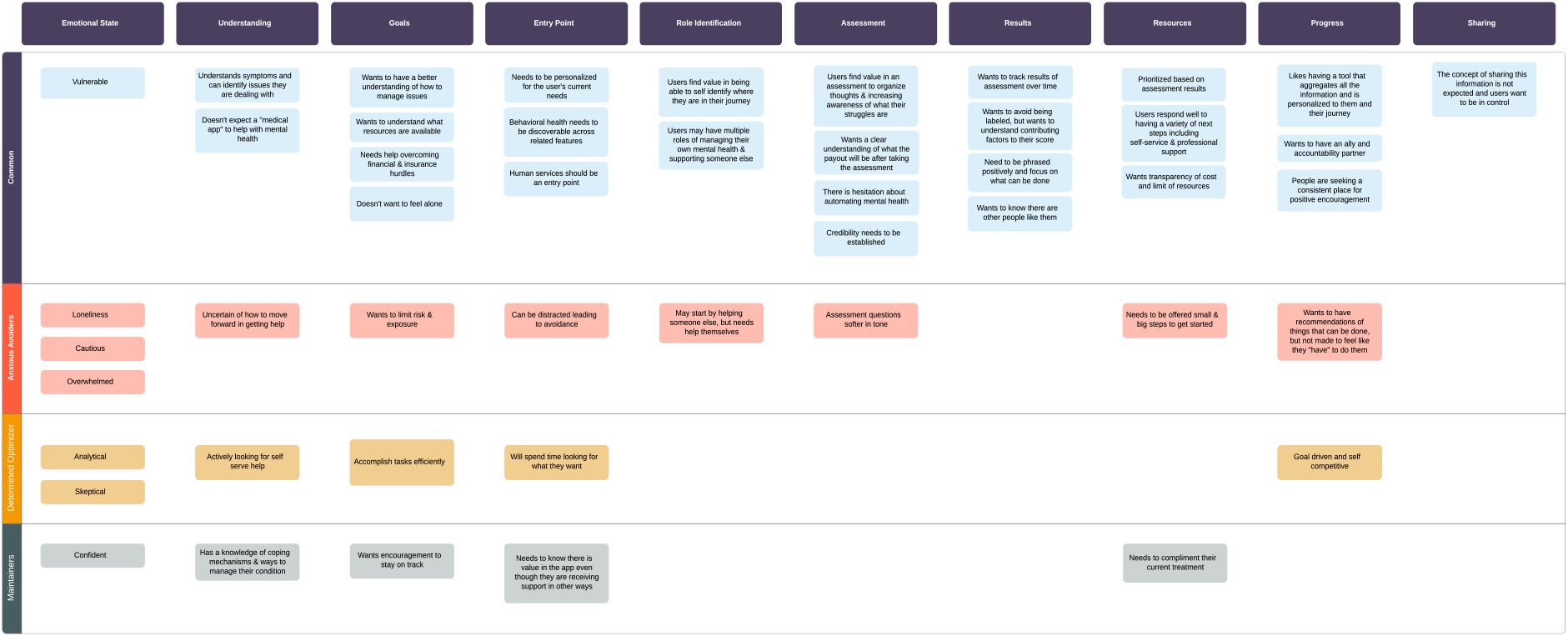Background
Journi is an app developed by Cambia Health Solutions that helps consumers manage the health of themselves and their family. It brings health records, humans services, and other tools into a single place for the consumer. Through the PDLC process Cambia explores opportunities to determine the future of the app. One of the proposed areas of exploration is “How might we better support individuals who are struggling with behavioral health?”. Pre-work had been done with research to narrow down our focus to the concept of assisting individuals though assessments. To understand the areas of opportunity, I partnered with Product Managers and a UX Researcher during this project.
Hypotheses
Supporting individuals’ behavioral health is a big space to explore. To narrow the scope, we began understanding the needs of consumers with depression and/or anxiety. From there, we developed a list of hypotheses that we wanted to test and grouped them into 3 buckets:
Consumers would trust…
Assessments to navigate resources & treatment options.
Care Guide support to navigate treatment options.
A behavioral health community for support and sharing their journey.
Consumers would use…
Journi when they have a behavioral health need.
An assessment if prompted based on health events.
Mental health assessment annually.
Recommended resources.
Consumers would engage by…
Accessing behavioral health support from Journi.
Tracking their behavioral health.
Tracking their family's behavioral health.
Refer service to other family members.
To get the answers to these hypotheses we needed needed to speak to consumers directly. We decided on conducting in-depth interviews across multiple regions.
Research Stimulus
During the interviews the researcher needed something that she could use to help move the conversation along and and would spark ideas with the consumer to highlight opportunities. I worked closely with the UX Research and developed some simple screens at key points in the journey. These were not intended to look or act like the final product, but to be a vehicle to spark conversation. Below are some of the key screens:
Consumer Interviews
Our next step was to conduct the interviews. We held 21 sessions at 3 locations: Seattle, Spokane, and Chicago. The interviews were conducted in research facilities where the UX Researcher sat in a room with the participant for 75 minutes and had a discussion with them. Prior to the interviews we had the participants do a bit of homework to prepare them for the types of questions we asked. I participated by observing the sessions though a two-way mirror and taking notes along with other key stakeholders. As the sessions progressed I was also on hand to make adjustments to the stimulus to better facilitate the conversation.
3 locations
Interviews were conduct in Seattle, Spokane & Chicago to draw insights from a diverse groups.
21 participants
1-hour homework
• Introduce self/background
• Evaluation of 3 apps.
• Collage ideal support toolkit.
75-minute interview
Research Synthesis
After the interviews wrapped up I worked with the UX Researcher to synthesize the research so that it could be shared with key stakeholders and used in subsequent workshops. One of the key artifacts we created was a variation of an experience map. We broke down the participants into groups and looked at the key points of their journey with behavioral health.
Above: Experience map during working session. Below: Complete digitized version.
Workshop
Once we did an initial round of synthesis, we shared the research to other teams across the company. We invited participants from our Human Wellness, Caregiving, & Mental Health teams to a workshop where we asked the question “How might we help people who are struggling with a low/medium/high level of depression or anxiety”. We broke out into groups, for each level of severity, and had them build a Creative Matrix. Each team then clustered their ideas and then plotted them into an Importance/Difficulty Matrix. This workshop sparked some new ideas for us to explore. It also showed that there was a lot of alignment around the ideas and how important and/or difficult they might be to achieve. The session was very productive with a lot of discussion.
Refining Personas
During our initial research synthesis we did some rudimentary persona building. We wanted to take these personas to the next step to help us fully articulate who we are designing our solutions for and what their struggles might be. We used pieces of the different stories we heard during our interviews and developed 3 personas; Diagnosed Maintainer, Undiagnosed Avoider, and a Parent support a younger child.
Concept Landing Page
We took the findings from the research, workshops and personas and designed a simple landing page that highlighted some of the features that were identified as opportunities for Journi. The page is written as a marketing piece that highlights the key features and how a user might interact with them. We conducted a study with this landing page through an online tool to gauge consumer interest in the concept.
We are also using this document to align on the direction of the project and get higher level stakeholders buy-in on the concept. For internal use we layered on the reasoning from the research as to why we might offer the feature. See the full size InVision document and use the same password used to access this page.
What’s next
This project is currently in process and is awaiting review from senior management. Our team is requesting that we take the findings from the research and work with subject matter experts to develop an alpha program. We would like to run the program with individuals suffering with Anxiety and/or Depression to see how they used the proposed tools and what impact it has on their mental-wellbeing.




















